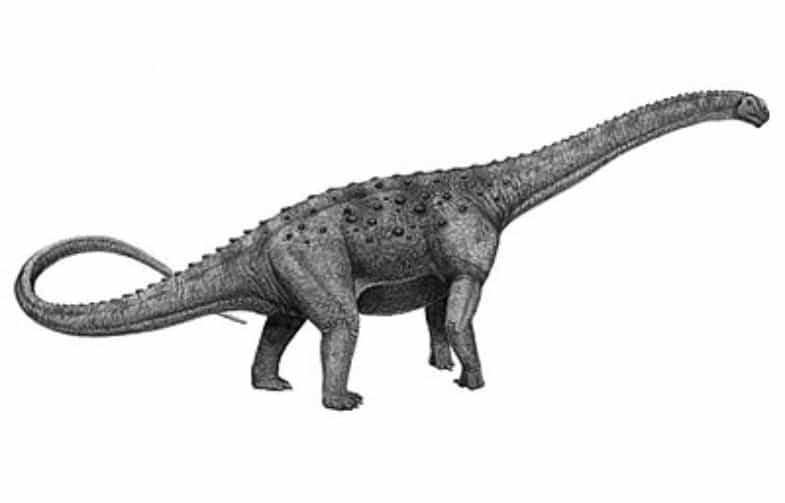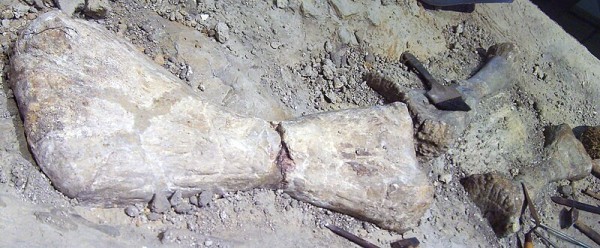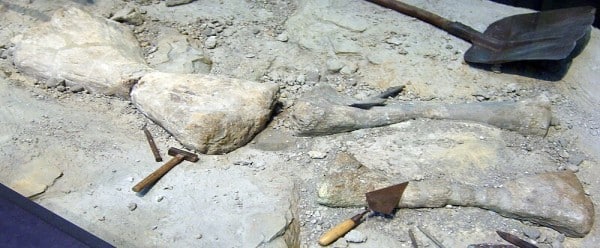Let’s embark on a journey back in time–specifically to the Late Jurassic Period–where a remarkable creature roamed the Earth. This creature, known as Janenschia, was a true marvel of its time. Discovered in the Lindi Region of Tanzania, Janenschia has intrigued paleontologists and dinosaur enthusiasts alike since its first discovery in 1907 by Eberhard Fraas.
Janenschia was named in honor of Werner Janensch who extensively studied the vertebrate fauna from Tendaguru. Its discovery not only added a new chapter to our understanding of the Late Jurassic Era but also provided insights into the diverse and complex world of Sauropods. As we delve deeper into the story of Janenschia, we uncover a narrative that spans millions of years and offers a glimpse into a world long gone.
Janenschia Key Facts
| Keyword | Fact |
|---|---|
| Pronunciation | yan-ensh-ee-ah |
| Meaning of name | named after Werner Janensch |
| Group | Sauropod |
| Family | Titanosaurid |
| Type Species | Janenschia robusta |
| Diet | Herbivore |
| When it Lived | 152.1 to 145 MYA |
| Period | Late Jurassic |
| Epoch | Tithonian |
| Length | Approximately 80.0 feet |
| Height | Approximately 18.0 feet |
| Weight | 11.0 to 33.0 tons |
| Mobility | Moved on all four |
| First Discovery | 1907 by Eberhard Fraas |
| Described by | 1908 by Eberhard Fraas |
| Holotype | SMNS 12144 |
| Location of first find | Lindi Region, Tanzania |
Janenschia Origins, Taxonomy and Timeline
The name of this dinosaur pays tribute to Werner Janensch, a notable figure in the study of vertebrate paleontology. The etymology of this dinosaur’s name is deeply rooted in the appreciation and recognition of Janensch’s contributions, particularly in his research at Tendaguru.

Belonging to the Sauropod group, this dinosaur is classified within the Titanosaurid family. This classification places it among some of the most colossal creatures that ever walked the Earth. The genus, with its type species Janenschia robusta, represents a unique lineage of only one species within the diverse and expansive sauropod clade.
The timeline of our story is set in the Late Jurassic Period, specifically during the Tithonian Epoch. This time frame spans from approximately 152.1 to 145 million years ago and situates Janenschia in a period of significant evolutionary and ecological developments. This makes it one of the oldest Titanosaurs. The Late Jurassic Era was a time of flourishing biodiversity and this herbivorous dinosaur was undoubtedly a part of this dynamic ecosystem.
Listen to Pronunciation
To hear the correct pronunciation of Janenschia, check out this video:
Discovery and Fossil Evidence
The story of this dinosaur’s discovery and naming is as intriguing as the dinosaur itself. In 1907, Eberhard Fraas unearthed two remarkable Sauropod skeletons, labeled as “Skeleton A” and “Skeleton B.” These finds were later transported to Stuttgart, Germany and marked the beginning of a complex nomenclatural journey. Initially, Fraas named both skeletons under the genus Gigantosaurus in 1908, with Skeleton A as Gigantosaurus africanus and Skeleton B, which is our focus, as Gigantosaurus robustus.
The name Gigantosaurus robustus, however, was short-lived. In 1911, Richard Sternfeld introduced the name Tornieria africana as the new designation for Skeleton A and reclassifying our robust Sauropod B as Tornieria robusta. Janensch argued for the retention of the Gigantosaurus name, citing the obscurity of the previously named G. megalonyx and advocating for nomenclatural stability. Despite Janensch’s resistance, the scientific community gradually leaned towards Tornieria as the valid name. By 1930, Baron Franz Nopcsa firmly established Tornieria as the appropriate genus, based on the rules of zoological nomenclature and the recognition of G. megalonyx in subsequent literature.


The final twist in this taxonomic tale came in 1991 when German paleontologist Rupert Wild recognized the distinct nature of our subject from Tornieria. He aptly renamed it Janenschia in honor of Werner Janensch’s significant contributions to the study of the Tendaguru fauna. This act not only resolved the longstanding naming confusion but also fittingly acknowledged Janensch’s dedication to paleontology.
Janenschia Size and Description
While the limited fossil record makes it difficult to paint a detailed picture of this dinosaur, its typical sauropod characteristics presents a fascinating subject for study. These sauropod physical attributes includes things such as locomotion style, body shape, and head structure. These characteristics not only distinguish Janenschia from other dinosaurs but also highlight its role in the ecosystem it inhabited.
Size and Weight of Type Species
The size and weight of Janenschia robusta have been subjects of much interest and study. While specific measurements for body length are not provided in the available data, it is reasonable to infer that Janenschia, like other Sauropods, was a sizable creature. One specimen, presumably a full grown adult, had a femur length of just over 4 feet. A study by Lehman and Woodward in 2008 used this femur length to calculate a body mass of over 14,000 kg, around 15.5 tons. The average size of Sauropods, combined with the known dimensions of related species, can offer a rough estimate of Janenschia’s size and it likely grew to be at least 60 feet long.
Interesting Points about Janenschia
- This dinosaur’s name is a tribute to Werner Janensch, reflecting the importance of historical figures in paleontology.
- As a member of the Titanosaurid family, Janenschia shares lineage with some of the largest creatures to have ever existed.
- This discovery in Tanzania highlights the global distribution of Sauropods during the Late Jurassic Period.
- Moving around on all four legs suggests a stable and robust lifestyle of a dinosaur well-adapted to its environment.
- The study of Janenschia’s fossils contributes to our understanding of Sauropod diversity and evolution.
Janenschia in its Natural Habitat
This herbivorous giant of the Late Jurassic thrived in an environment that was both challenging and bountiful. The climate during this period was likely warm and humid with lush vegetation providing ample food sources for this massive herbivore. The geography, characterized by vast plains and possibly dense forests, would have been ideal for a creature of Janenschia’s size and dietary needs.
The diet primarily consisted of plant material, which indicates a lifestyle that was both sedentary and foraging. As a Sauropod, its long neck would have been advantageous in reaching high vegetation while its size could have deterred potential predators. The social behavior of Janenschia is not definitively known, but, like many Sauropods, it might have lived in herds for added protection and social interaction.
Its impact on its habitat would have been significant. As a large herbivore, it likely played a role in shaping the vegetation and possibly even the landscape. Its feeding habits and movement patterns would have influenced the ecosystem around it, contributing to the dynamic interplay of life during the Late Jurassic.
Contemporary Dinosaurs
In the lush, ancient landscapes where Janenschia roamed, life was a constant dance of survival and coexistence. The robust frame and long neck of this hefty herbivorous dinosaur was a sight to behold. It shared its world with the likes of Giraffatitan, a fellow herbivore, but one that towered over even Janenschia like a skyscraper. These two giants likely browsed different levels of foliage, with Giraffatitan reaching the higher branches and Janenschia content with lower vegetation. This natural separation of dining preferences meant they weren’t direct competitors despite their similar diets.
Then there was Dicraeosaurus, another herbivore smaller than both Janenschia and Giraffatitan. This smaller size likely made Dicraeosaurus more agile, able to navigate through denser parts of the forest where larger dinosaurs couldn’t follow. Janenschia might have seen Dicraeosaurus as a minor competitor, but their size difference and potential variation in diet likely minimized any serious rivalry.
But life wasn’t all about peaceful grazing. Elaphrosaurus, a lithe and potentially carnivorous dinosaur, added a hint of danger to this world. While Elaphrosaurus was significantly smaller than Janenschia, its speed and agility could have made it a threat to younger or weaker Sauropods. The presence of such predators meant that Janenschia had to be constantly aware of its surroundings despite its size.
Lastly, there was Kentrosaurus–a smaller, spiky herbivore. While not a direct competitor for food, the presence of Kentrosaurus added to the dynamic ecosystem these dinosaurs called home. Their coexistence likely had little direct impact on Janenschia, but it’s fascinating to imagine these diverse species sharing the same space, each playing their unique role in the ancient dance of life and survival.
Frequently Asked Questions
The name honors Werner Janensch, a significant figure in the study of vertebrate paleontology.
It was discovered in 1907 in the Lindi Region of Tanzania.
It was an herbivore, primarily feeding on plant material that it could reach with its long neck.
Janenschia lived during the Late Jurassic Period, approximately 152.1 to 145 million years ago.
It moved on all four legs, typical of Sauropod locomotion.
The first fossils were found in the Lindi Region of Tanzania.
Sources
The information in this article is based on various sources, drawing on scientific research, fossil evidence, and expert analysis. The aim is to provide a comprehensive and accurate overview of Janenschia. However, please be aware that our understanding of dinosaurs and their world is constantly evolving as new discoveries are made.
- https://www.researchgate.net/publication/286584783_Review_of_Janenschia_wild_with_the_description_of_a_new_sauropod_from_the_Tendaguru_beds_of_Tanzania_and_a_discussion_on_the_systematic_value_of_procoelous_caudal_vertebrae_in_the_sauropoda
- https://www.researchgate.net/publication/289919206_Janenschia_n_g_robusta_E_Fraas_1908_pro_Tornieria_robusta_E_Fraas_1908_Reptilia_Saurischia_Sauropodomorpha_tp=eyJjb250ZXh0Ijp7InBhZ2UiOiJwdWJsaWNhdGlvbiIsInByZXZpb3VzUGFnZSI6bnVsbH19
- https://www.researchgate.net/publication/287960300_Sauropod_dinosaurs_from_the_central_Zambezi_Valley_Zimbabwe_and_the_age_of_the_Kadzi_Formation_tp=eyJjb250ZXh0Ijp7InBhZ2UiOiJwdWJsaWNhdGlvbiIsInByZXZpb3VzUGFnZSI6bnVsbH19
This article was last fact-checked: Joey Arboleda, 11-30-2023
Featured Image Credit: National HIstory Museum
